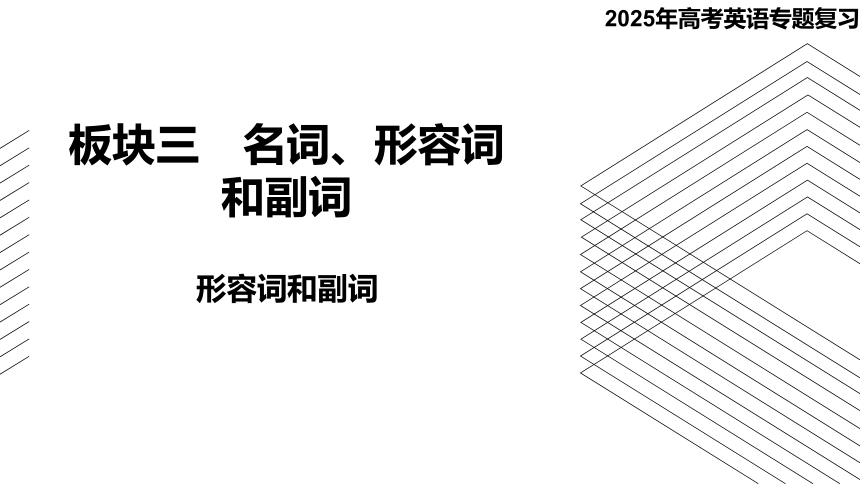(
课件网) 板块三 名词、形容词和副词 形容词和副词 2025年高考英语专题复习 1.(2023·新课标Ⅰ卷)Xiao long bao (soup dumplings), those amazing constructions of delicate dumpling wrappers encasing hot, _____ (taste)soup and sweet,fresh meat, are far and away my favorite Chinese street food. 2.(2023·新课标Ⅱ卷)Since June 2017, right before the arrival of the two new pandas, Meng Meng and Jiao Qing, I have been helping the panda keepers at the zoo to feel more comfortable and _____ (confidence) speaking English. tasty confident 考点一 形容词和副词的基本用法 3.(2023·浙江1月卷)The term “hutong”,_____ (original) meaning “water well” in Mongolian, appeared first during the Yuan Dynasty. 4.(2022·新高考Ⅰ卷)The GPNP’s main goal is to improve connectivity between separate populations and homes of giant pandas, and _____ (eventual) achieve a desired level of population in the wild. originally eventually 1.形容词的基本用法 (1)形容词在句中可作定语、表语、宾语补足语、主语补足语、状语等。 As a unique part of Chinese culture, Chinese characters have a long history and various ways of creating new characters and expressing plentiful meanings. 作为中国文化独一无二的部分,中国汉字历史悠久,并以各种方式创造新的汉字,表达丰富的内涵。 Conditions were so bad that it was impossible for the police to find the trail again. 天气状况太差,警察想再找到踪迹是不可能的。 (2)形容词作状语主要表示原因、结果或伴随等,其逻辑主语必须与句子主语保持一致。 Flushed and breathless, she bounded in through the gate. 她满脸通红,气喘吁吁,从大门口蹦蹦跳跳地跑了进来。 常见的以-ly结尾的形容词:friendly, lovely, lively, lonely, elderly, deadly 等。 2.副词的基本用法 (1)副词主要用来修饰动词、形容词、其他副词或修饰整个句子,表示时间、地点、程度、方式等。 In China, it is a virtue and tradition to respect our teachers, who unselfishly help us to gain much knowledge. 在中国,尊敬我们的老师是一种美德和传统,他们无私地帮助我们获得很多知识。 (2)常考的连接性副词:though“然而,可是”(用于句末), meanwhile“在此期间”,therefore/thus/consequently“因此,所以”,moreover/furthermore“而且,此外”,besides“另外,还有”,however“然而”,instead“相反,代替”,anyway/anyhow“尽管,即使这样”,otherwise“否则”。 The young man couldn’t afford a new car. Instead, he bought a used one. 那个年轻人买不起新车,便买了一辆二手的。 易用错的几类副词 (1)意义有别的同根副词:free(免费地)/freely(自由地), hard(努力地)/hardly(几乎不), late(晚,迟)/lately(最近), most(很,最)/mostly(主要地), fair(公平地)/fairly(相当地), near(临近)/nearly(几乎)等。 (2)有些副词有两种形式,以-ly结尾时表示抽象意义;与形容词同形的表示具体意义:close(接近)/closely(密切地), wide(宽地)/widely(广泛地), high(高地)/highly(高度地), deep(深地)/deeply(深深地)。 1.(2023·浙江1月卷)Their siheyuan were far smaller in scale and _____ (simple) in design and decoration, and the hutongs were narrower. 2.(2022·全国甲卷)In the last five years, Cao has walked through 34 countries in six continen ... ...

